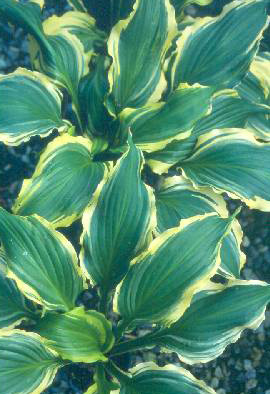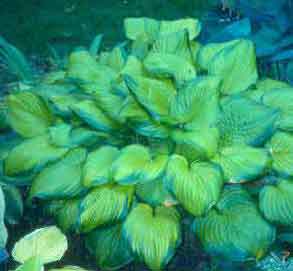Why
hostas?
by
Bob Solberg
A newspaper reporter from Memphis
recently asked me, “Why are hostas so popular?”
It is true that hostas have become the
number one selling perennial in the United States. There are two major facts
that produce these statistics. First, there are lots of different cultivars of
hostas currently in the nursery trade, maybe as many as 2000. Only daylilies
outstrip hostas in sheer numbers of different kinds in existence but few garden
centers stock hundreds of different daylily cultivars. Many garden centers do,
however, carry 200, 300, even 400 or
more different hostas, usually in quantities of 10-25 each.
Secondly, hostas are expensive compared to other perennials, averaging
$10-15 per gallon container. New
introductions routinely sell for $50-$100 each, many others retail for $20-$30.
So not only are hostas the leading selling perennial in quantity but probably
in total dollars also.
These facts explain the statistics but
they have really nothing to do with “why hostas are so popular.” I have several
theories.
Hostas fill a very important landscape
niche, (actually habitat), in the shade garden. They offer luxuriant tropical
foliage in a wide variety of sizes and colors in parts of the country where
tropical plants are not hardy. Better yet they demand cold to such a degree that many of my hosta friends swear that
their hostas always “do better” after a hard winter. In Minnesota, Northern
Illinois and Michigan hostas are often used as foundation plants. I always
thought that was because evergreen azaleas and Japanese hollies are not hardy
there but it may be because sleeping hostas can handle snow loads much better
than yews and boxwoods.
Hostas appeal to the collector in all
of us. We can collect them by color. I
particularly like blue ones. We can collect them by size, mini’s especially.
(Most gardens will only hold but so many giant ‘Sum and Substance’ like clumps
but they can accommodate lots of little ones!) We can collect the fragrant
flowered ones and/or the ones with “moon” in their names. We can try to collect
all 50 or so species, collected from the wild of course, or we can go for it
all, and try to collect them all! Most serious hosta nuts are collectors or
reformed collectors.

Hosta 'Ginsu Knife' (left)
In truth, however, I feel that it is
their humanness that really hooks us on
hostas. Hostas mimic our gardening emotions throughout the growing season, (or
do we mimic them?). In the long nights of winter they sleep long hours safe in
their beds. Like us they may get depressed and dream of spring, there is no way
to know.
With the arrival of the warmer days of
spring they emerge from the ground with such enthusiasm that it is contagious.
We hosta crazies spend countless hours wandering the garden from clump to clump
urging them on, counting the fat divisions, calculating the dividends on our
investments. ("I bought one division of that one last year for $25.00 and now,
oh boy, it is coming up four. It’s a hundred dollar clump!”) We are constantly
pulling back the mulch, helping the minis come through and poking our fingers
around in the soil checking on those late rising sleepyheads. I remember one
time going out to take the trash and suddenly realized that I’d been exploring
in the garden for 45 minutes before I knew it.
In spring, hostas grow amazingly fast.
Faster than puppies, more like hogs. Likewise, they have an amazing appetite in
May and June, for nitrogen and water. They make new leaves happily on those
warm, dewy mornings after an overnight rain but risk dehydration, like we do,
on those “perfect” bright spring days with record low humidity.
Then with the heat of summer, our
thoughts turn to flowers. The sieboldianas and montanas
throw up their white or light lavender flowers in response but go almost
unnoticed as the brighter colors of newly planted annuals capture our
attention. The late flowering hostas, especially the fragrant children of H.plantaginea, continue to throw up
flushes of new foliage enjoying the afternoon heat. Now as the humidity builds,
all but the most intrepid hostaphiles retreat inside to enjoy the garden
through the plate glass window with the benefit of air conditioning.
By August the garden and the gardener
begin to look tired. Both are a little brown around the edges. The drought and
the resulting continuous lugging of hoses has taken its toll on all the
garden’s residents. Irrigation has become a chore. Then that escape to the
beach, when the rain did not fall and the spigot remained closed, has gotten
both petioles and spirits drooping. All thoughts turn to the coolness of winter
and sleep.
The late flowering hostas hurry to
ripen their seeds, while the early ones have already formed their dormant buds
and are functionally dormant. The dogwood
drops a leaf. As we order mulch, check labels and think garden clean-up,
our hostas drop off to sleep like an over tired child, with one shoe off and one shoe on. There is just
enough time to clean them up and tuck them in before the snow flies.

Hosta 'Guacamole' (left)
We love hostas because we live with
them. We share the garden and the gardening season with our hosta friends. We
share their joys and their sufferings. Our lives are intertwined. We love them
because we live like them.
There is one other thing about hostas; they bring out the humanity in us. I call them a “social” plant. They are designed to chop up and pass over the fence. The most fun about hostas is giving them away. We give them to our neighbors who become our hosta friends. That is why the AHS has named the hosta the “Friendship Plant”, and rightly so. This is the real reason why hostas are the most popular perennial in the country, they are a people plant.